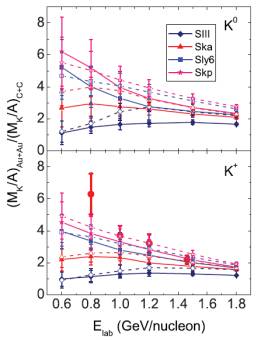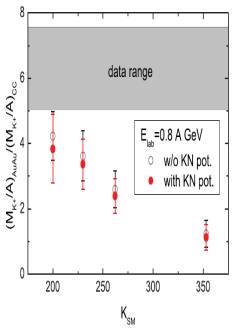The production of strange particles in high-energy heavy-ion collisions was investigated systematically to extract the high-density information of isospin symmetric nuclear equation of state (EoS) based on the Lanzhou Quantum Molecular Dynamics (LQMD) model that was developed by Institute of Modern Physics, Chinese Academy of Sciences (IMP). The results show that a soft EoS is favored by comparing calculations with the available data of K+ production measured by KaoS collaboration.
It has important role of the properties of the high- density EoS on the issues of astrophysics, such as the structure of neutron star, the nucleosynthesis during supernova explosion of massive stars etc. The establishment of high-energy heavy-ion facilities in the world provides a platform to explore the high-density behavior of compressed nuclear matter, such as HIRFL-CSR at IMP in China, SIS18 and FAIR at GSI in Germany. Theoretically, physical observables of the high-density information of nuclear phase diagram measured in laboratories can be investigated with microscopic transport models. The LQMD model has been applied to treat fusion dynamics near Coulomb barrier, isospin physics and in-medium modifications of particle production. Strange particles in particular for kaon emissions are produced at the early stage in nucleus-nucleus collisions from the LQMD calculations (Physical Review C 82, 057901 (2010)), namely in the compression process. Therefore, the high-density information of nuclear phase diagram can be extracted from kaon production in heavy-ion collisions.
Different potential parameters can be chosen in the LQMD model, which result in a different compression modulus of symmetric nuclear matter. The same density dependence of isospin asymmetric part in the mean-field potential is used for all potential parameters. Namely, a linear dependence of the symmetry energy with baryon density is taken in this work. Shown in Fig. 1 is a comparison of the double ratios of kaons (K0 and K+) per mass numbers of reaction partners produced in central 197Au+197Au over 12C+12C collisions for the cases of different potential parameters, and also compared with the KaoS data for the K+ production. The experimental data can be well reproduced with the Skyrme parameter Skp, which corresponds to the compression modulus of KSM=200 MeV for symmetric nuclear matter. Inclusion of the in-medium kaon-nucleon(KN) potential does not change the distributions. The calculated ratio of K+ with different compression modulus is compared with the KaoS data at sub-threshold energy Elab=0.8A GeV. It is clear that a soft EoS is close to experimental data.
This work was supported by the National Natural Science Foundation of China under Grant No. 10805061, the Special Foundation of the President Fund, and the West Doctoral Project of Chinese Academy of Sciences.
The results have been published in Physical Review C 83, 067604 (2011).
The article can be linked as follows:
URL: http://link.aps.org/doi/10.1103/PhysRevC.83.067604


Fig. 1 Calculated excitation functions of the ratios of K multiplicities obtained in 197Au+197Au over 12C+12C reactions for head-on collisions at different Skyrme forces (left panel) and double ratios calculated within the LQMD model at incident energy of 0.8A GeV as a function of the incompressibility coefficient KSM (right panel), and compared with the available data from KaoS collaboration for K+ production. (Image by IMP)

